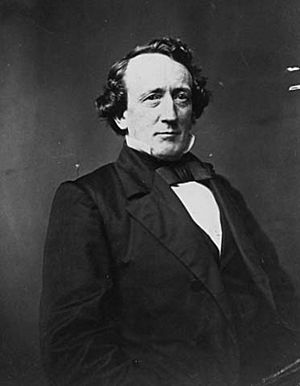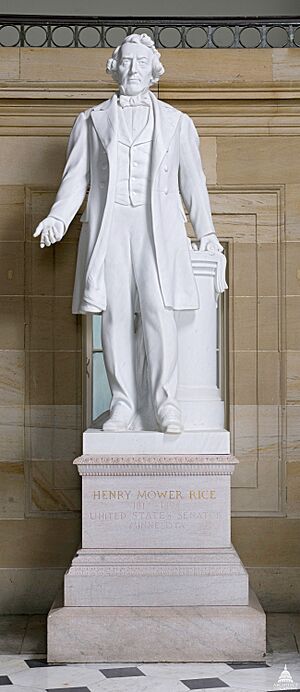Henry Mower Rice facts for kids
Quick facts for kids
Henry Rice
|
|
|---|---|
 |
|
| United States Senator from Minnesota |
|
| In office May 11, 1858 – March 3, 1863 |
|
| Preceded by | Seat established |
| Succeeded by | Alexander Ramsey |
| Delegate to the U.S. House of Representatives from the Minnesota Territory's at-large district |
|
| In office March 4, 1853 – March 3, 1857 |
|
| Preceded by | Henry Sibley |
| Succeeded by | William W. Kingsbury |
| Personal details | |
| Born |
Henry Mower Rice
November 29, 1816 Waitsfield, Vermont, U.S. |
| Died | January 15, 1894 (aged 77) San Antonio, Texas, U.S. |
| Political party | Democratic |
| Spouse | Matilda Whital |
| Children | 9 |
Henry Mower Rice (born November 29, 1816 – died January 15, 1894) was an important American politician. He was also a fur trader who played a big role in making Minnesota a state.
Contents
Early Life and Adventures
Henry Rice was born in Waitsfield, Vermont, on November 29, 1816. He grew up with family friends because his father passed away when Henry was young.
When he was 18, Henry moved to Detroit, Michigan. There, he helped survey a canal route. This canal was planned around the rapids of Sault Ste. Marie. It would connect Lake Superior and Lake Huron.
In 1839, Rice got a job at Fort Snelling. This fort was near what is now Minneapolis, Minnesota. He became a fur trader, working with the Ho-Chunk and Chippewa (Ojibwe) Native American tribes. He earned their trust and became very influential. Henry Rice was key in helping the United States make an important agreement with the Ojibwe people in 1847. Through this agreement, they shared large areas of land.
Henry Rice's Political Journey
Henry Rice worked hard to create the Minnesota Territory in 1849. Later, he served as its representative in the U.S. House of Representatives. He was a delegate from March 4, 1853, to March 4, 1857. His efforts on the Minnesota Enabling Act were very important. This act was passed in 1857 and helped Minnesota become a state.
Henry Rice was a member of the Democratic Party. He was known for his connections to the fur trade. In 1858, when Minnesota became a state, Henry Rice and James Shields were chosen by the state legislature. They became U.S. Senators. Rice served as a Senator from May 11, 1858, to March 4, 1863. He did not run for re-election. Later, in 1865, he tried to become governor but was not successful.
Rice also served on the board of regents for the University of Minnesota. This was from 1851 to 1859. He was also the president of the Minnesota Historical Society.
Henry Rice was involved in several agreements with Native American tribes. He helped with treaties with the Ojibwe people in 1847 and 1854. He also helped with the Ojibwe of Minnesota in 1887 and 1888. He played a role in helping the Ho-Chunk people move in 1848 and 1850.
Henry Rice passed away on January 15, 1894. He was visiting San Antonio, Texas, at the time.
Henry Rice's Lasting Legacy
In 1916, the state of Minnesota gave a marble statue of Henry Rice to the National Statuary Hall Collection. This collection is located in the United States Capitol building in Washington, D.C. Rice County, Minnesota is named after him. His brother, Edmund Rice, also served in the U.S. House of Representatives.
An earlier marble statue of Rice was placed in the Minnesota State Capitol in 1906.
See also
- List of United States senators expelled or censured


